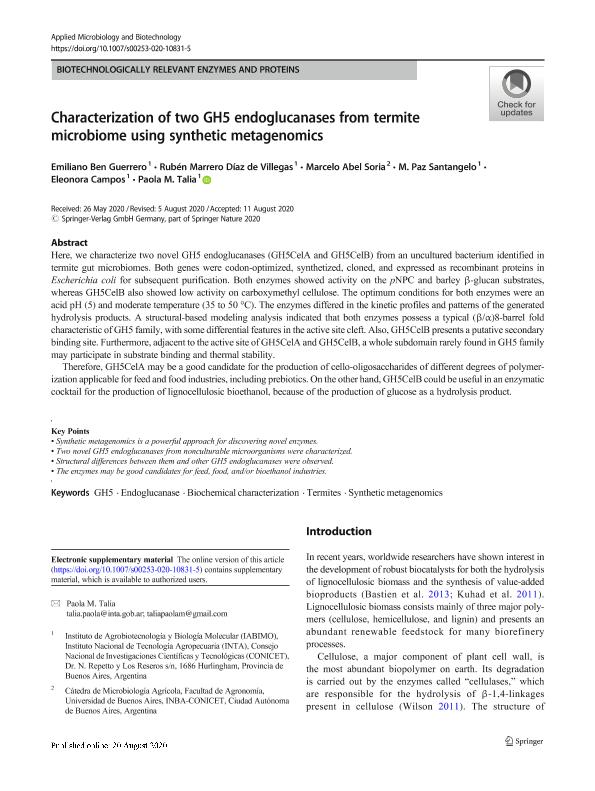Mostrar el registro sencillo del ítem
dc.contributor.author
Ben Guerrero, Emiliano

dc.contributor.author
Marrero Díaz de Villegas, Rubén
dc.contributor.author
Soria, Marcelo Abel

dc.contributor.author
Santangelo, María de la Paz

dc.contributor.author
Campos, Eleonora

dc.contributor.author
Talia, Paola Monica

dc.date.available
2021-10-04T13:30:34Z
dc.date.issued
2020-08-20
dc.identifier.citation
Ben Guerrero, Emiliano; Marrero Díaz de Villegas, Rubén; Soria, Marcelo Abel; Santangelo, María de la Paz; Campos, Eleonora; et al.; Characterization of two GH5 endoglucanases from termite microbiome using synthetic metagenomics; Springer; Applied Microbiology and Biotechnology; 104; 19; 20-8-2020; 8351-8366
dc.identifier.issn
0175-7598
dc.identifier.uri
http://hdl.handle.net/11336/142425
dc.description.abstract
Here, we characterize two novel GH5 endoglucanases (GH5CelA and GH5CelB) from an uncultured bacterium identified in termite gut microbiomes. Both genes were codon-optimized, synthetized, cloned, and expressed as recombinant proteins in Escherichia coli for subsequent purification. Both enzymes showed activity on the pNPC and barley β-glucan substrates, whereas GH5CelB also showed low activity on carboxymethyl cellulose. The optimum conditions for both enzymes were an acid pH (5) and moderate temperature (35 to 50 °C). The enzymes differed in the kinetic profiles and patterns of the generated hydrolysis products. A structural-based modeling analysis indicated that both enzymes possess a typical (β/α)8-barrel fold characteristic of GH5 family, with some differential features in the active site cleft. Also, GH5CelB presents a putative secondary binding site. Furthermore, adjacent to the active site of GH5CelA and GH5CelB, a whole subdomain rarely found in GH5 family may participate in substrate binding and thermal stability. Therefore, GH5CelA may be a good candidate for the production of cello-oligosaccharides of different degrees of polymerization applicable for feed and food industries, including prebiotics. On the other hand, GH5CelB could be useful in an enzymatic cocktail for the production of lignocellulosic bioethanol, because of the production of glucose as a hydrolysis product.
dc.format
application/pdf
dc.language.iso
eng
dc.publisher
Springer

dc.rights
info:eu-repo/semantics/openAccess
dc.rights.uri
https://creativecommons.org/licenses/by-nc-sa/2.5/ar/
dc.subject
BIOCHEMICAL CHARACTERIZATION
dc.subject
ENDOGLUCANASE
dc.subject
GH5
dc.subject
SYNTHETIC METAGENOMICS
dc.subject
TERMITES
dc.subject.classification
Agricultura

dc.subject.classification
Agricultura, Silvicultura y Pesca

dc.subject.classification
CIENCIAS AGRÍCOLAS

dc.title
Characterization of two GH5 endoglucanases from termite microbiome using synthetic metagenomics
dc.type
info:eu-repo/semantics/article
dc.type
info:ar-repo/semantics/artículo
dc.type
info:eu-repo/semantics/publishedVersion
dc.date.updated
2021-09-07T14:59:31Z
dc.journal.volume
104
dc.journal.number
19
dc.journal.pagination
8351-8366
dc.journal.pais
Alemania

dc.journal.ciudad
Berlin
dc.description.fil
Fil: Ben Guerrero, Emiliano. Instituto Nacional de Tecnología Agropecuaria. Centro de Investigación En Ciencias Veterinarias y Agronómicas. Instituto de Agrobiotecnología y Biología Molecular. Consejo Nacional de Investigaciones Científicas y Técnicas. Oficina de Coordinación Administrativa Parque Centenario. Instituto de Agrobiotecnología y Biología Molecular; Argentina
dc.description.fil
Fil: Marrero Díaz de Villegas, Rubén. Instituto Nacional de Tecnología Agropecuaria. Centro de Investigación En Ciencias Veterinarias y Agronómicas. Instituto de Agrobiotecnología y Biología Molecular. Consejo Nacional de Investigaciones Científicas y Técnicas. Oficina de Coordinación Administrativa Parque Centenario. Instituto de Agrobiotecnología y Biología Molecular; Argentina
dc.description.fil
Fil: Soria, Marcelo Abel. Consejo Nacional de Investigaciones Científicas y Técnicas. Oficina de Coordinación Administrativa Parque Centenario. Instituto de Investigaciones en Biociencias Agrícolas y Ambientales. Universidad de Buenos Aires. Facultad de Agronomía. Instituto de Investigaciones en Biociencias Agrícolas y Ambientales; Argentina
dc.description.fil
Fil: Santangelo, María de la Paz. Instituto Nacional de Tecnología Agropecuaria. Centro de Investigación En Ciencias Veterinarias y Agronómicas. Instituto de Agrobiotecnología y Biología Molecular. Consejo Nacional de Investigaciones Científicas y Técnicas. Oficina de Coordinación Administrativa Parque Centenario. Instituto de Agrobiotecnología y Biología Molecular; Argentina
dc.description.fil
Fil: Campos, Eleonora. Instituto Nacional de Tecnología Agropecuaria. Centro de Investigación En Ciencias Veterinarias y Agronómicas. Instituto de Agrobiotecnología y Biología Molecular. Consejo Nacional de Investigaciones Científicas y Técnicas. Oficina de Coordinación Administrativa Parque Centenario. Instituto de Agrobiotecnología y Biología Molecular; Argentina
dc.description.fil
Fil: Talia, Paola Monica. Instituto Nacional de Tecnología Agropecuaria. Centro de Investigación En Ciencias Veterinarias y Agronómicas. Instituto de Agrobiotecnología y Biología Molecular. Consejo Nacional de Investigaciones Científicas y Técnicas. Oficina de Coordinación Administrativa Parque Centenario. Instituto de Agrobiotecnología y Biología Molecular; Argentina
dc.journal.title
Applied Microbiology and Biotechnology

dc.relation.alternativeid
info:eu-repo/semantics/altIdentifier/url/http://link.springer.com/10.1007/s00253-020-10831-5
dc.relation.alternativeid
info:eu-repo/semantics/altIdentifier/doi/http://dx.doi.org/10.1007/s00253-020-10831-5
Archivos asociados
